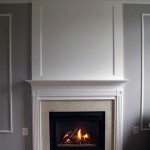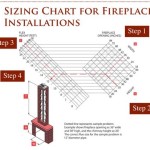Convert Fireplace To Propane Gas: A Comprehensive Guide
Converting a traditional wood-burning fireplace to propane gas offers numerous advantages, including increased convenience, cleaner burning, and improved efficiency. This process involves replacing the existing firebox and hearth with propane-compatible components and installing a gas line. This guide will provide a comprehensive overview of converting a fireplace to propane gas, addressing essential considerations and steps involved.
Understanding the Conversion Process
The conversion process entails replacing the existing firebox and hearth with gas-compatible components designed for propane. This typically involves installing a propane burner, a gas log set, and a vent system compatible with propane combustion. The existing chimney will usually be repurposed to vent the propane gases, though modifications might be necessary to ensure proper ventilation.
Before embarking on the conversion, it is crucial to assess the fireplace's structural integrity. An inspection by a qualified professional can identify potential issues, such as cracks or damage, that need addressing before proceeding with the conversion. Additionally, a professional assessment will determine the appropriate size and type of gas burner and log set for optimal performance and safety.
Essential Considerations for Conversion
Several factors must be considered before making the decision to convert a fireplace to propane gas. These include:
Cost
Converting a fireplace to propane gas is a significant investment. The cost varies depending on the size and complexity of the fireplace, the type of gas burner and log set chosen, and the cost of labor. It is essential to obtain quotes from multiple qualified professionals before making a decision.
Safety
Safety is paramount when dealing with propane gas. Converting a fireplace to propane requires adherence to strict safety standards. A qualified professional must install the propane system, ensuring proper ventilation and leak detection. It is also crucial to understand and follow all safety guidelines provided by the manufacturer and local authorities.
Efficiency
Propane fireplaces are generally more efficient than wood-burning fireplaces, meaning they produce more heat with less fuel. However, the efficiency of a propane fireplace can vary depending on the quality of the gas burner and log set. It is important to choose a propane system that provides the desired heating output and fuel efficiency.
Installing a Propane Fireplace
After carefully considering the factors mentioned above and securing all necessary permits and inspections, you can proceed with the installation of a propane fireplace. The steps involved in the installation process include:
1. Disconnect Existing Firebox
Start by disconnecting the existing firebox from the chimney. This may involve removing any existing firebricks, grates, or other components.
2. Install Propane Burner
The propane burner is the heart of the gas fireplace. It is responsible for generating the flames that create the fire. The burner is typically mounted within the fireplace, connected to a gas line. Ensure the propane burner is correctly sized for the fireplace and properly installed according to the manufacturer's instructions.
3. Install Gas Log Set
The gas log set simulates the look of a real wood fire. It consists of ceramic or cast iron logs that are strategically placed within the firebox to create a natural and aesthetic fire effect. The gas log set is typically connected to the propane burner and should be installed according to the manufacturer's instructions.
4. Install Vent System
A vent system is essential for safely venting the combustion gases from the fireplace. The venting system should be properly sized and installed to ensure that these gases are safely channeled to the exterior of the house. Local building codes will dictate the required venting specifications.
5. Connect Gas Line
A licensed plumber or gas fitter must connect the propane burner to a dedicated propane line. This line should be properly sized to deliver sufficient gas to the burner and should be installed according to local building codes.
6. Seal and Insulate
After installing the propane system, it's essential to properly seal and insulate the fireplace to prevent heat loss and ensure safe operation. The area surrounding the propane burner and vent system should be sealed with high-temperature sealant. The fireplace should also be properly insulated to minimize heat loss.
7. Inspection and Approval
Upon completion of the installation, a qualified inspector should check the system for compliance with local building codes and safety standards. Once the inspection is approved, you can safely operate your new propane fireplace.
Converting a fireplace to propane gas can be an excellent way to enhance its functionality and convenience while maintaining a traditional aesthetic. By carefully considering the factors involved and engaging the services of a qualified professional, you can enjoy the benefits of a safe, efficient, and visually appealing propane fireplace.

Convert Your Wood Burning Fireplace To Propane Ny

Can A Wood Burning Fireplace Be Converted To Gas The Flame Company

How To Convert A Wood Fireplace Propane

Convert From Wood To Gas With A Insert The Kernel Burner

Converting A Gas Fireplace To Propane Pros And Cons Faber Fire

Best Gas Fireplace Inserts Fireplaces Direct Learning Center

How To Convert Your Wood Burning Fireplace Electric Or Gas

Convert Your Wood Or Gas Fireplace Fuel Type Conversions

Convert From Wood To Gas With A Insert The Kernel Burner

Convert A Wood Fireplace To Gas Full Service Chimney








